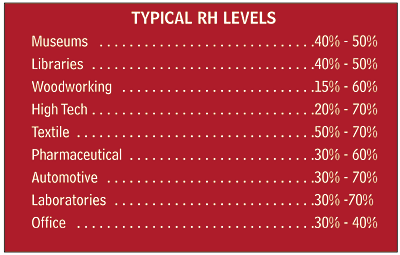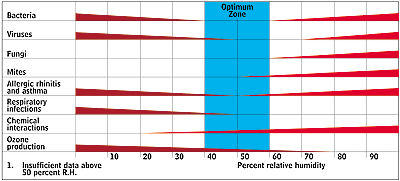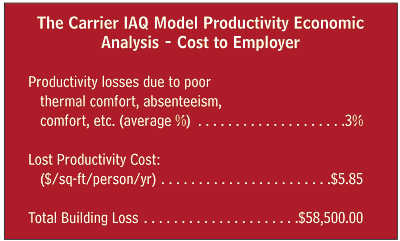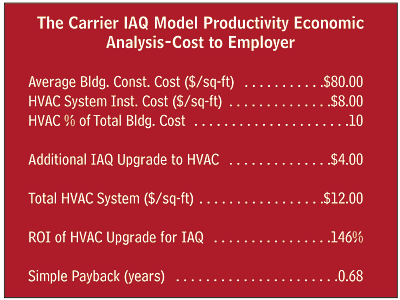Two of the primary factors that are required for a suitable indoor environment are temperature and relative humidity (rh). Temperature control is always a considered parameter when designing a workspace. However, proper control of rh and its relationship to Indoor Air Quality (IAQ) are overlooked many times.
Poor IAQ can have a significant negative effect on the employee's health and productivity. Productivity losses are an easily measured component. They can be evaluated by the quality and quantity of the work accomplished by the employees.
The IAQ of the work environment can have a dramatic impact on the health care cost for an employer. Increased absenteeism and chronic health problems have been directly related to the IAQ of indoor office environments. Thermal comfort is a main parameter that has a dramatic effect on the occupant's perception of the workplace. It is also one of the most easily controlled and understood parameters. It can have an influence on the well-being of occupants within governmental and institutional buildings, retail buildings, offices, schools, hospitals, elder care facilities, etc.
This paper will summarize many studies completed over the past several years that relate the IEQ and/or IAQ of a work environment to the comfort and well-being of the occupants. It will also show the cost benefits associated with not only maintaining comfort through temperature control but also by achieving proper indoor rh control.

IEQ And IAQ
Building owners and tenants have become increasingly concerned about their buildings' IEQ which is composed of factors such as space temperature, humidity, noise, lighting, interior design and layout, envelope, etc. A subset of IEQ is IAQ. The factors that define IAQ are temperature, humidity, room air motion, and contamination. With poor IAQ, employees can suffer significant impairment of health and productivity.1As the electronic age appeared, a significant change occurred within the work- place. The percentage of white-collar to blue-collar employees increased significantly along with a dramatic increase in the salary levels of the white-collar workers. Increased use of electronic systems within the work environment requires employees with greater skills to complete assignments. IAQ has a direct influence on these employees, their productivity, and the profitability of their employer.
A 1999 BOMA/ULI tenant survey indicated that the tenants' concern for comfort (95%) and IAQ (94%) have come dramatically to the forefront in recent years and must be considered as the owner renovates an existing edifice or is in the design process of a new building.
Over the years, a significant number of IAQ studies have been published on critical problems that have occurred and caused great distress to the occupants of the buildings. These are usually the studies that are published by the media and become well known. Many have a high cost to remediate.
However, when evaluating these studies, one must keep in mind that there are many more cases where simple, common sense solutions could be taken to solve an IAQ problem. When reviewing IAQ information, it becomes apparent that only a small portion of the cases (i.e., less than a quarter) are true war stories such as those created by microbial, chemical, or bacterial contaminants. The majority of IAQ complaints are comfort related or start as a comfort-related incident.
Comfort complaints such as the space being too hot or cold or too moist or too dry are commonly reported and in many cases easily solved. In most instances when comfort complaints are acted upon quickly, the tenants are satisfied and the complaint disappears. However, when a complaint is disregarded and not acted upon, it can achieve a much greater significance to other employees. When this happens, the once-simple IAQ complaint can expand into a much greater and more expensive problem to solve for the occupants of the building and its owner.
The expense created by an IAQ problem does not stop at the cost of the remedial actions required. Costs related to absenteeism, productivity, health care, etc. must be added to the equation and could easily exceed those of remediation by a large sum.

Ventilation For IAQ
During the 1970s and 1980s, many buildings were constructed or renovated to increase their energy efficiency and lower their cost of operation. In order to achieve the greatest energy savings, the buildings were highly insulated, tightly constructed to reduce infiltration or ex-filtration of air, and the hvac systems were designed to maintain the least amount of ventilation air possible.Unfortunately, these construction techniques allowed the build-up of contaminants within the buildings, many times to the detriment of the occupants. The concentration of chemical and biological contaminants, along with dust, odors, and elevated humidity levels within the workplace, resulted in severe complaints from the occupants.
The American Society of Heating, Refrigerating and Air-Conditioning Engineers (ASHRAE) was called upon to revise its Standard 62 to reduce the IAQ problems created by tightly designed buildings. This standard recommended a minimum of 15 to 20 cfm of fresh air be introduced into an occupied building in order to dilute the contaminants within the building and carry them safely outside. This approach has proven to be successful, in most instances, and has become the standard of the construction industry.

Ventilation And Humidity Control
The introduction of outdoor air into a building using the guidelines of ASHRAE 62 was very positive for the reduction of indoor contaminants. Fifteen cfm of fresh air per person creates about one air change (ach) in a space. However, this outdoor air can directly influence the comfort and well-being of the occupants because of its effect on the indoor rh.Increasing the ventilation air can dramatically affect the indoor rh, and create conditions that are either too hot or too cold for the occupant. Usually, a modern, properly designed hvac system will maintain rh within the 50% to 60% comfort levels during warm moist periods of the year. However, when the hvac system does not have the capacity to properly humidify or dehumidify the air within the building, the comfort level of the occupants may be adversely affected.

How Warm Do You Feel?
High rh levels reduce the capability of the air to evaporate water from the skin of the occupants. This reduces the body's ability to keep cool and comfortable. The increased ventilation has a completely different effect during winter or periods of cold weather. Cold air holds very little moisture; when it is introduced into the space, it will dramatically reduce the indoor rh. When outside air at 0°F is admitted into a space and heated to 70°, the residual indoor rh will drop to as low as 3%. Even during a mild winter day when the outdoor conditions are 35° and 50% rh, the indoor humidity levels will drop as low as 14% (Figure 1).The Sahara Desert has an average rh of 25%. The introduction of cold outdoor air in the recommended quantities for IAQ will create sub-desert conditions within the work environment unless humidification equipment is installed.
Warm air with a low rh has the ability to evaporate large quantities of moisture from the skin of the occupants within the space. As the water evaporates, it cools the body making the occupants feel cold and clammy. Increasing the indoor temperature may help eliminate some of the cooling effect; however, the rh will be reduced even further. Figure 2 shows the effect that relative humidity has on the comfort level of building occupants, in terms of its affect on the heat index.
In the previous study, the tenants indicated 95% of the time that comfort was their first concern in the work environment. Tenant comfort depends on the direct effect of indoor temperature and rh. If either is too high or too low, it can have a detrimental consequence on the comfort level. Increasing the rh level in summer or winter has a direct effect on the occupants' comfort level.

Why Humidity Control?
Manufacturers have realized for many years that their processes and machines operate best at optimum environmental conditions. Research indicated that controlling the indoor temperature within the 72° to 76° range was optimum for most process work. Proper rh levels are also required for dimensional stability, reduction of static electricity and dust, curing processes, production speed, chemical reactions, etc.Static electricity is mainly a dry weather condition and not only affects processes but also the modern, high-tech office. Static can cause computers to crash, electronic keys to malfunction, and many other expensive problems. The effects that humidity has on a process can mean the difference between meeting a production schedule and higher profit margins. Typical applications are listed in Figure 3.
The increasing demands created by IEQ and IAQ have caused this thinking to be extended to an even more valuable asset: PEOPLE! Humidity control in warm and cold weather can have a significant effect on the comfort, productivity, and well-being of the occupants. This is well documented in many past and recent studies. Previous information concluded that a 20% to 80% rh within the normal work environment was acceptable.
In Dr. Elia Sterling's 1985 study, Criteria for Human Exposure to Humidity in Occupied Buildings, he reviewed the psychological effects that indoor rh levels had on people and concluded that the optimum range should be within the 40%-60% range. This study is recapped in Figure 4.
Dr. Sterling's study details the effects that both high and low relative humidity levels have on people in the workplace. At the midrange, many of the bacteria, viruses, etc. lose their viability, and many cases studies indicate the organisms died and have little affect on the occupants.
As the rh rises, bacteria, viruses, etc. have an increasingly greater detrimental affect on the occupants. In the modern office environment, high rh levels are usually reduced to the 50% or 60% level by a properly designed hvac system.
However, as shown in Figure 1, the humidity can drop to the subdesert conditions as low as 3% rh. The Sterling chart indicates this will have a dramatic and detrimental affect on the occupants. The key item that demonstrates this is the section showing respiratory infections on the chart. Dry skin problems, flu, colds, pneumonia, and other respiratory ailments are usually associated with wintertime conditions when the indoor rh levels are at their lowest levels.
These lead to greatly increased absenteeism levels and lost productivity, costing billions of dollars to employers each year. Significant increases in the cost of health care benefits can be attributed to wintertime ailments. Many studies have shown that absenteeism increases dramatically in the wintertime. The results are usually consistent with studies by Dr. George Green of the University of Saskatchewan (G.H. Green, Indoor Relative Humidities in Winter and the Related Absenteeism, ASHRAE CH-85-13 NO3 [RP-397]). Green's research in 12 public schools showed a 20% reduction in absenteeism in all schools when the rh was raised from 20% to 35%.
Healthy Buildings International Magazine has published numerous articles and studies on the effect of IAQ and humidity on the workplace. Their information is consistent with that presented in the studies mentioned above. One major study, "Factors Affecting Employee Health and Comfort," indicated that the top three factors affecting the employees were allergic fungi at 32%, dust at 28%, and low relative humidity at 27%. The first is mainly created by conditions such as wet floors, damp surfaces, high humidity, etc.
Dust in the workplace is generally much more prevalent during warm, dry conditions. This is because abrasion causes dry carpet and clothing fibers to become airborne along with hair follicles, skin flakes, and other contaminants to increase the dust within the space. Low rh could easily be the number one factor in this IAQ study due to its relationship with the creation of dust. A recap of the study is shown in Figure 5A.

IAQ Economic Model
Carrier Corporation (Syracuse, NY) recently produced a model showing the economic benefits of controlling IAQ. This model compared the cost of modifying the hvac system for IAQ, its return on investment (ROI) against the actual cost of the employees, and losses due to absenteeism and productivity, etc. Figures 5A-5D review this study.This chart compares the cost of operating the building against those of the employee salary. It indicates the actual cost per sq/ft for each employee is much higher than the cost of operating the building.
The average cost of a standard hvac system is $8/sq ft, compared to $80/sq ft for the building. The study suggests the hvac system should be upgraded at a cost of $4/sq ft additional for IAQ purposes. This allows an ROI of 146% and a simple payback of approximately seven months.
If the tenant moves from a building because of IAQ concerns, the owner will incur considerable expenses in order to rent the space. If the owner had upgraded the hvac system to solve the IAQ concerns and the tenant did not move, the ROI would have been as high as 341%, with a simple payback in less than four months.

Humidification Upgrade
Installing air conditioning to cool and dehumidify a building is common practice. A building owner would have a difficult time renting a building if this equipment is not installed and risks losing tenants if it is not operating properly. The above study assumes that upgrading the hvac system at a cost of $4/sq ft can easily be recovered in less than one year through savings in employee productivity, health, and comfort.This same comparison can be extended to the installation of humidification equipment to remediate similar and possibly greater losses created by low rh. Using the building from the Carrier model as a guideline, the cost of a humidification system has been estimated. An electric humidifier was used to produce comparative results as those found in the field (Figure 6).
Figure 6 indicates that humidification is only 12% of the recommended hvac upgrade cost. This makes humidification one of the least expensive upgrades that can be made to a building. Humidification easily achieves the desired benefits by increasing productivity, comfort, and well-being of the employees and reducing absenteeism.
The IAQ benefits achieved through cooling and dehumidifying in warm weather can easily be achieved or exceeded during the colder months of the year through proper humidification.

Humidification Equipment Review
Humidification devices have a long history in homes and businesses. The cast iron kettle that grandmothers used on their wood stoves indicates the long acceptance that dry indoor air is unhealthy.Modern office buildings require more sophisticated humidifiers, and the manufacturers have met the challenge by offering a variety of equipment. The selection of a humidifier to properly meet the demands of the application should be discussed with a qualified professional.
The technologies available offer differing first cost and operational costs, which should be evaluated by the building owner and the tenant. A humidifier selected for its low first cost may have high operating costs, while a humidifier with a higher initial price may easily pay for itself within a short period of time through lower operating costs. Application, ease of installation, maintenance, water conditions, and many other parameters should be examined when selecting a humidification system.
Two basic groups of humidification systems are available, and each has several different types that can be used depending on the application, as shown in Figure 7. The difference between these two groups of humidifiers is where they obtain the heat required for evaporation of the water.
The amount of energy used to heat water is the Btu, enough to heat one pound of water 1°; the energy required to evaporate the water by either type of humidifier is the same, at about 970 Btu/lb. The type of energy, its availability, and cost are all parameters that must be considered when selecting a humidification system.
The type of water available and its mineral content are also important when selecting a humidification system. High mineral content can create maintenance and housekeeping problems if not evaluated beforehand.

Adiabatic Humidifiers
Adiabatic humidifiers use heat from the air in the space or hvac system to evaporate the water. They will cool the hvac system or surrounding air as the water is evaporated. If the building requires cooling when the humidification system is operating, the system can provide energy savings by reducing the amount of mechanical cooling required or allowing a change in the mix of outdoor air with the air flowing through the hvac system.One pound of water evaporated into 1,000 cfm of air moving through an hvac system will lower the air temperature by 1°. If the space does not require cooling, energy must be added to the air to counter the cooling created by the adiabatic humidifier. The amount of energy used to overcome this cooling is the same as that required to create a similar quantity of steam or evaporate the water within an isothermal humidifier.
Adiabatic atomizing systems discharge waterborne minerals directly into the space. Filtering the water will not remove these minerals, and softening will simply change the calcium to sodium This can be very corrosive when it settles onto surfaces within the space. Water treatment systems such as deionization or reverse osmosis (DI/RO) system will remove the minerals but will add to the cost of operating the humidification system.
Atomizing humidifiers with open reservoirs must be carefully maintained to eliminate the buildup of bacteria, algae, and other contaminants, which can be discharged directly into the space.

Isothermal Humidifiers
Isothermal humidifiers' heat is added directly to the water using electricity, oil, or gas as the energy source to evaporate or turn the water into steam.Isothermal humidifiers cleanly evaporate water or turn it into clean steam. The minerals remain within the humidifier reservoir and must be removed periodically in order to keep the unit operating properly. Softening the water supplied to an isothermal humidifier usually reduces the maintenance considerably. Most isothermal humidifiers are designed with periodic drains to carry the minerals away and reduce maintenance.
In buildings where heating the space is required throughout the humidification season, the isothermal humidifier is usually preferred. Steam is very forgiving when discharged within the confines of the hvac system or directly into the space. It evaporates rapidly and does not affect the temperature within the space when controlled properly.
Steam boilers usually require a chemical treatment system to reduce oxidation and keep the minerals in suspension to allow them to be discharged during the system blowdown. The chemicals can create IAQ problems if they are not properly metered into the system. In order to reduce this concern, designers select boiler systems that are specifically used for humidification without water treatment chemicals or boilers which are capable of using DI/RO water in order to eliminate the chemical treatment requirement.
Each of the above humidifiers can be used for many applications. Selection should be reviewed by a qualified professional to decide which system will meet the requirements of the project, the building owner, and the occupants.
IAQ Liabilities
IAQ litigation is increasing at a surprisingly high rate. The building owner or company that is not concerned about their employees' welfare will not only suffer from the problems of absenteeism and productivity losses, but also from the high expense of litigation.The New Webster's Dictionary defines air conditioning as: "The process of regulating the quality, temperature, humidity, and circulation of air in a space enclosure." These are the criteria for basic comfort management for the occupants within the modern office environment. The designer, building owner, or management company who disregards this is opening the doors to litigation which will be much more costly than any savings assumed to be created by not maintaining proper indoor comfort conditions.
Conclusion
The premise behind the concerns for IAQ and IEQ are the comfort and well-being of the occupants within the workplace. The modern workforce has changed, with increased numbers of highly skilled and talented employees in the close confines of the office place. Losses in productivity within this workforce can be extremely expensive to the employer and requires new thinking regarding the work environment.Thermal comfort is a main component of IAQ and IEQ and has been shown to be the primary concern of occupants in many studies. The low cost of addressing a thermal comfort condition can be greatly exceeded by the expensive losses created by increased illnesses, discomfort, absenteeism, and poor productivity. Health care costs are also skyrocketing, adding to the expenses of the employer and the desire to avoid preventable health issues.
In warmer climates and weather conditions, the acceptable indoor conditions can usually be attained through a properly designed hvac system, which will ventilate the space and heat, cool, dehumidify, and filter the air distributed into the space. Maintaining the desired 50% to 60% rh indoors is easily accomplished with the typical hvac system during this period.
The introduction of dry outside air through the ventilation system in colder weather can reduce the indoor relative humidity to subarid conditions as low as 3%. The low humidity causes the occupants to feel chilled and uncomfortable and also causes increased susceptibility to colds; flu; pneumonia; dry skin; dry itchy eyes; and contact lens irritation.
Absenteeism in the workplace is much more prevalent during colder weather due to the above causes. It costs the employers billions of dollars in salary and productivity losses annually. The installation of a humidification system designed to maintain 35% to 45% rh during colder weather is highly recommended to maintain proper comfort and well-being of the occupants. The benefits gained in increased productivity and reduced absenteeism will allow a return on investment within a very short period of time. Humidity control in the modern office space is essential to IAQ and IEQ. ES
References
American Society of Heating, Refrigerating and Air-Conditioning Engineers, Inc., ANSI/ASHRAE Standard 55-1992, Thermal Environmental Conditions for Human Occupancy (Atlanta, 1992).American Society of Heating, Refrigerating and Air-Conditioning Engineers, Inc., ANSI/ASHRAE Standard 62-1989R Ventilation for Acceptable Indoor Air Quality (Atlanta, 1989).
Berlin, Gary L. "The Advancement in Steam Humidification Technology to Provide a Cleaner Indoor Environment," ASHRAE Seminar (1995).
BOMA/ULI Tenant IAQ Survey (1999).
Brundrett, G. W., "TM13 - Minimizing The Risk Of Legionnaires' Disease," The Chartered Institution of Building Services Engineers (London,1987).
"Carrier IAQ Model: IAQ And Productivity: How Much Does Poor Air Quality Cost?" Indoor Air Quality Update (Oct. 1996).
Collett, C.W., "Strategies for the Investigation of Indoor Air Quality Problems and Findings From Their Implementation," ASHRAE Transaction #DE-93-19-2 (1993).
Davis, J.W., Ph.D., P.E., "Analysis of Furnace-Mount Humidifier for Microbiological and Particle Emissions - Part 1: Test System Development," ASHRAE Transaction # CH-93-18-1 (1993).
Dorgan, Chad B., P.E., "Health and Productivity Benefits of Improved Indoor Air Quality," ASHRAE (1998).
Green, George H., "The Effect of Indoor Relative Humidity on Absenteeism & Colds In Schools," ASHRAE Journal (January 1975).
Green, George H., "Indoor Relative Humidity in Winter and the Related Absenteeisms," ASHRAE Transaction #CH-85-13-3 (RP-397).
Highsmith, V. Ross, "Indoor Particle Concentrations Associated With Use of Tap Water in Portable Humidifiers," Environmental Science & Technology, (Sept. 1988): 1109.
"IAQ A Concern In EPA's Planned $232 Mil. Research Facility," Indoor Air Quality Update (Oct. 1996).
Rhodes, W.W., Ph.D., P.E., "Control of Microbioaerosol Contamination in Critical Areas in the Hospital Environment," ASHRAE Transaction # DA-88-12-1 (1988).
Rudd, C.O., Ph.D., P.E., "Analysis of Furnace-Mount Humidifier for Microbiological and Particle Emissions - Part ll: Particle Sampling and Results," ASHRAE Transaction #CH-93-18-2 (1993).
Stepanek, Steven, "Better Indoor Air Via Hvac Operation," Buildings (March 1992).
Sterling, E.M., "Criteria for Human Exposure to Humidity in Occupied Buildings," ASHRAE Transaction # CH-85-13-1 (1985).
Tur, Dr.W., "Scientific Documentation on the Influence of Humidity on Health," Zurick, 1988.
Unz, R.F., Ph.D., "Analysis of Furnace-Mount Humidifier for Microbiological and Particle Emissions - Part III, Microbiological Sampling and Results," ASHRAE Transaction #CH-93-18-3 (1993).
Vischer, J.C., Ph.D., "Using Occupants' Experiences to Monitor Air Quality in Office Buildings," ASHRAE Transaction DE-93-19-3 (1993).
